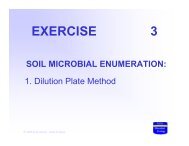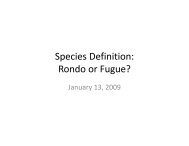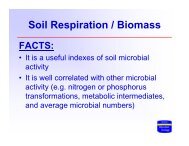Soil Microbial Ecology - Soil Molecular Ecology Laboratory
Soil Microbial Ecology - Soil Molecular Ecology Laboratory
Soil Microbial Ecology - Soil Molecular Ecology Laboratory
Create successful ePaper yourself
Turn your PDF publications into a flip-book with our unique Google optimized e-Paper software.
Page 51<br />
E X E R C I S E<br />
8<br />
SOIL METABOLIC ASSESMENT<br />
2. RESPIRATION / BIOMASS TESTS<br />
RESPIRATION<br />
OBJECTIVE:<br />
Quantify soil microbial activities by measuring carbon dioxide production in treatments<br />
of different carbon sources.<br />
INTRODUCTION:<br />
Respiration of microorganisms in soil was one of the earliest, and still is one of the most<br />
frequently, used indices of soil microbial activity. Measurements of respiration have<br />
been found to be well correlated with other parameters of microbial activity such as<br />
nitrogen or phosphorus transformations, metabolic intermediates, and average microbial<br />
numbers<br />
Carbon comprises about 45 to 50% of the dry matter of plant and animal tissues. When<br />
these tissues or residues are metabolized by microorganisms, 0 2 is consumed and C0 2 is<br />
evolved in accordance with the following generalized reaction:<br />
(CH 2 0) x + 0 2 ⎯⎯⎯⎯⎯⎯→ C0 2 + H 2 0 + intermediates + cell material + energy<br />
In this reaction, all of the organic carbon should eventually be released as C0 2 . In actual<br />
practice, under normal aerobic conditions, only 60 to 80% of the carbon is evolved as<br />
C0 2 because of incomplete oxidation and synthesis of cellular and intermediary<br />
substances. The quantities of C0 2 evolved depend on the type of carbon substrate, the<br />
environmental conditions, and the types and numbers of microorganisms involved.





